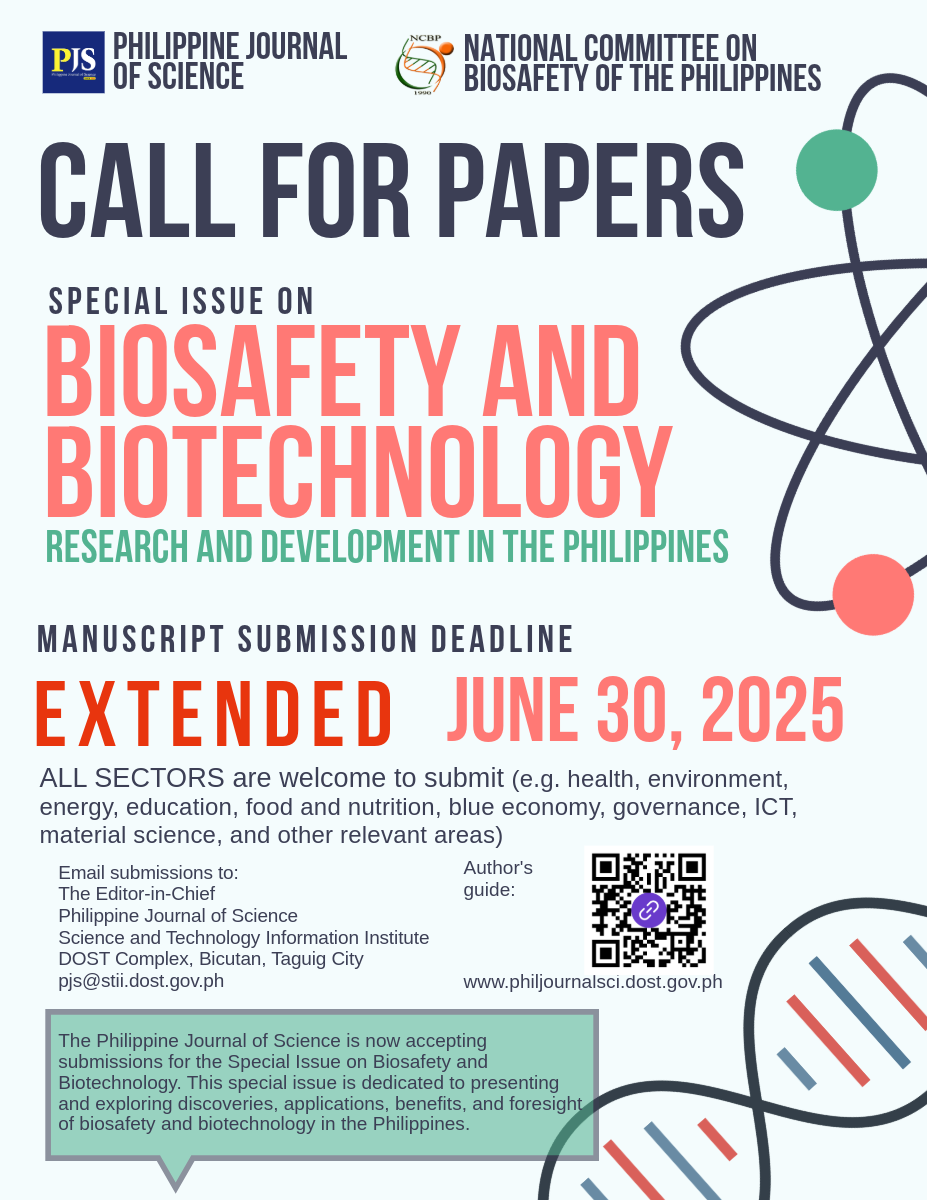Degradation of Residual Jatropha Oil by a Promising Lipase-Producing Bacterial Consortium
Armi R. Creencia1, Bernadette C. Mendoza2,Veronica P. Migo1 and Rosario G. Monsalud1
1National Institute of Molecular Biology and Biotechnology (BIOTECH),
University of the Philippines Los Baños, College, Laguna
1Institute of Biological Sciences (IBS),
University of the Philippines Los Baños, College, Laguna
corresponding author: This email address is being protected from spambots. You need JavaScript enabled to view it.
ABSTRACT
The study was conducted to assess the potential of using lipase-producing bacteria in degrading the residual oil from Jatropha curcas L. biodiesel wastewater. Bacterial isolates were qualitatively and quantitatively screened for lipase activities. Oil degradation efficiencies of the bacteria were evaluated. Conditions (medium composition, initial medium pH, initial substrate concentration and culture incubation time) for oil degradation were partially optimized. The three most promising lipase-producing bacteria (and their respective lipase activity), namely: BDF-2 (35.67 U/mL), BOcMFW-2 (19.50 U/mL) and BOcMJL-12 (19.33 U/mL), identified as Bacillus cereus, Pseudoalteromonas byunsanensis and Arthrobacter sp., respectively were selected for further testing. The oil degradation assay, under partially optimized conditions (i.e., Medium #5, pH 7, 1% residual Jatropha oil substrate), revealed that the mixed culture containing these three bacteria could degrade up to 96.99% of residual Jatropha oil after 7-8 d of incubation with continuous agitation. This bacterial consortium may be used as a promising strategy for the treatment lipid-rich wastes.
INTRODUCTION
The oftentimes increasing price of petroleum and the continuing global environmental concerns have been the main reasons for exploring the use of cleaner burning fuels. In the Philippines, the use of biofuels has been mandated by the government under Republic Act 9367. It ensures the availability of alternative and renewable, clean energy without much detriment to the environment (Philippine Republic Act 2006). However, high demands for petroleum alternatives will entail the generation of tremendous amounts of biodiesel wastewater, which may then result to difficulties in wastewater disposal. Such environmental concerns can possibly be addressed by tapping microbial resources in order to degrade wastes that are rich in lipids. . . . . . . . . . .
REFERENCES
CAMMAROTA MC, FREIRE DMG. 2006. A review on hydrolytic enzymes in the treatment of wastewater with high oil and grease content. Bioresource Tech 97: 2195-2210.
CASA EP. 2001. Biodegradation of fats and oils in wastewater using lipophilic yeasts. [MS]. Los Baños, Laguna: University of the Philippines Los Baños. 98p. (available at UPLB Library)
CHEN SJ, CHENG CY, CHEN TL. 1998. Production of an alkaline lipase by Acinetobacter radioresistens. J Ferment Bioeng 86: 308-312.
CREENCIA AR, MENDOZA BC, MIGO VP, MONSALUD RG. 2013. Characterization and identification of bacteria in a consortium capable of degrading residual Jatropha biodiesel wastewater oil. Philipp J Sci 142(2): 115-124.
GARRITY GM, BRENNER DJ, KRIEG NR, STALEY JT. 2005. Bergey’s Manual of Systematic Bacteriology. 2nd ed. Vol. 2 Part B. New York, USA: Springer. 1106p.
HABA E, BRESCO O, FERRER C, MARQUES A, BUSQUETS M, MANRESA A. 2000. Isolation of lipase-secreting bacteria by deploying used frying oil as selective substrate. Enzym Microb Tech 26: 40-44.
HASAN F, SHAH AA, HAMEED A. 2009. Methods for detection and characterization of lipases: A comprehensive review. Biotechnol Adv.
JAEGER KE, RANSAC S, DIJKSTRA BW, COLSON C, HEUVEL MV, MISSET O. 1994. Bacterial Lipases. FEMS Microbiology Reviews 15: 29-63.
JONES D, KEDDIE R. 2006. The Genus Arthrobacter. In: Dworkin M, Falkow S, Rosenberg E, Schleifer K, Stackebrandt E, eds. The Prokaryotes. 3rd ed. Vol. 3. New York, USA: Springer. p. 945-960.
KOUKER G, JAEGER K. 1987. Specific and sensitive plate assay for bacterial lipases. Appl and Envt Microl 53(1): 211-213.
KHYAMI-HORANI H. 1996. Thermotolerant strain of Bacillus licheniformis producing lipase. World J Microbiol and Biotech 12: 399-401.
KUNITSKY C, OSTERHOUT G, SASSER M. 2000. Identification of microorganisms using fatty acid methyl ester (FAME) analysis and the MIDI Sherlock Microbial Identification System. Encyclopedia of Rapid Microbiological Methods. Newark, USA: MIDI, Inc. 17p.
MADIGAN MT, MARTINKO JM, STAHL D, CLARK DP. 2011. Brock Biology of Microorganisms. 13th ed. Boston, MA, USA: Benjamin Cummings Publishing Company. 1152 pages.
MALIK KA. 1991. Maintenance of Microorganisms by Simple Methods. In: Kirsop BE, Doyle A. Maintenance of Microorganisms and Cultured Cells. 2nd ed. London: Academic Press, Inc. p. 121-132.
MATSUMIYA Y, WAKITA D, KIMURA A, SANPA S, KUBO M. 2007. Isolation and characterization of a lipid-degrading bacterium and its application to lipid-containing wastewater treatment. J Bioscience and Bioeng 103(4): 325-330.
MONGKOLTHANARUK W, DHARMSTHITI S. 2002. Biodegradation of lipid-rich wastewater by a mixed bacterial consortium. Int Biodeterior Biodegrad 50(2): 101-105.
MUKRED AM, HAMID AA, HAMZAH A, YUSOFF WMW. 2008. Development of three bacterial consortium for the bioremediation of crude petroleum oil in contaminated water. J Biol Sci 8(4): 73-79.
RAYMUNDO AK, ZAMORA AF, DALMACIO IF. 1991. Manual on Microbiological Techniques. Philippines: Technology and Livelihood Resource Center. p. 17-31.
RECKNAGEL RD, BORMANN EJ, FRIEDRICH W. 1988. Improvement of medium composition by random balance designs. J Basic Microbiol 28: 659- 666.
SUEHARA K, KAWAMOTO Y, FUJII E, KOHDA J, NAKANO Y, YANO T. 2005. Biological treatment of wastewater discharged from biodiesel fuel production plant with alkali-catalyzed transesterification. J Bioscience and Bioeng 100(4): 437-442.
TANO-DEBRAH K, FUKUYAMA S, OTONARI N, TANIGUCHI F, OGURA M. 1999. An inoculum for the aerobic treatment of wastewaters with high concentration of fats and oils. Bioresour Technol 69: 133-139.
[US EPA] UNITED STATES ENVIRONMENTAL PROTECTION AGENCY. 1999. Method 1664, revision A: n-hexane extractable material (HEM; oil and grease) and silica gel treated n-hexane extractable material (SGT-HEM; non-polar material) by extraction and gravimetry. EPA-821-R-98-002.
VON WEDEL R. 1999. Technical Handbook for Marine Biodiesel. 2nd ed. Point Richmond, CA, USA: CytoCulture International, Inc. 32p.
WILSON K. 1994. Preparation of genomic DNA from Bacteria. In: Ausubel FM, Brent R, Kingston RE, Moore D, Seidman JG, Smith JA, Struhl K, eds. Current Protocols in Molecular Biology. Vol. 1. USA: John Wiley and Sons, Inc. 5p.
ZHEN-QIAN Z, CHUN-YUN G. 2009. Screening for lipase-producing Enterobacter agglomerans for biodiesel catalyzation. Afr J Biotechnol 8(7):1273-79. Retrieved from http://www.senate.gov.ph/republic_acts/ ra%209367.pdf on June 26, 2012. http://www.ncbi.nlm.nih.gov http://rdp.cme.msu.edu









